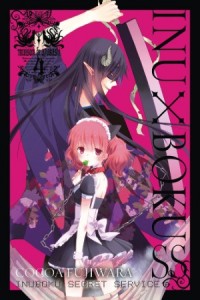By Cocoa Fujiwara. Released in Japan by Square Enix, serialization ongoing in the magazine Gangan Joker. Released in North America by Yen Press.
This is one of those volumes where I recommend that if you enjoy the series and haven’t read it, you avoid reading my review so that you aren’t totally spoiled. Just an FYI. In fact, let’s put an image here to block it off.
Admittedly, much like Higurashi, I suspect that the spoiler of “everyone dies” is something that most fans of the series knew before they picked this up. There is an anime, and it’s the type of series that appeals more to hardcore fans than casual ones, I think. This is not to say this isn’t a good volume – it is pretty good, and I think has done a nice job of telegraphing things. But we now know that this was meant to be a prologue to the main story, which presumably takes place in the future when everyone is reincarnated again. And as such, I think the odd pacing of the first few volumes make sense – the author wanted to have enough volumes so that this had an emotional impact, but didn’t really have enough for everyone to do so stretched a lot out.
It’s not helped that I feel the cast is a bit too big for a series that depends so much on emotional two-hander relationships. Sure, we get lots of time devoted to our leads, but I still can never quite remember the names when they’re all said in a group, particularly as they’re all fancy 4-5 syllable rich and hard to remember names. And we get more people introduced here, as we see the old woman who seems to be in charge of the yokai group, her young assistant, and the evil kid who seems to be behind the attacks that kill everyone off.
This leads to the other issue I had with this volume – the author is much better at either dumb comedy or romantic drama than they are at actual action scenes. The final battle is somewhat confusing and brings in too many elements, and is not helped by it fading out once Soushi dies. This does lead to what I think are the strengths of both this volume and the series – the comedy and the romance. Both are not for everyone – they depend very much on being familiar with and not minding the standard Japanese romance tropes, where the girl is flustered and the boy is smooth and skilled. Better written is the relationship between Watanuki and Carta, where he pleads with her not to give up after she’s found she can’t change out of her skeletal form, and that he loves her no matter what she looks like. It’s my favorite part of the book.
In the end, I expect that how I feel about the first four volumes will be affected by what comes next, i.e. how much do the actions of the past weight on the seemingly reincarnated heroes? Certainly the last few pages play up the fact that reincarnated Ririchiyo is exactly the same as the one we’re familiar with, to the point of using the exact same starting gags. As for Soushi, he now wears glasses, but will he still have the uber-devoted attitude? What changes and what stays the same will make or break a series like this. And while I think it’s flawed, I’m interested enough in Vol. 5 to check it out.


Speak Your Mind